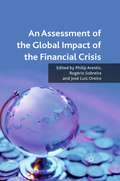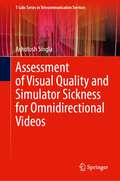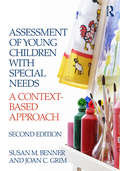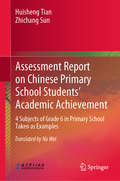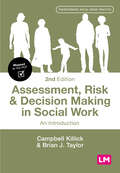- Table View
- List View
An Assessment of the Global Impact of the Financial Crisis
by Philip Arestis, Rogéo Sobreira & Joséuis OreiroThis topical volume analyzes the impact of the 2008 financial crisis. It considers the origins and explanations of the current crisis, examines the regulatory implications and, with specific focus on developing countries, it provides a strategy for economic growth that can guarantee financial stability in the future.
Assessment of the Nuclear Programs of Iran and North Korea
by Jungmin KangWhen we are looking at proliferation cases, there are a number of lessons – positive and negative – learnt. First, facts reported by the IAEA are essential for the international community in assessing the compliance and risks of possible clandestine activities. Second, the IAEA verification scheme is biting when it fully exercises its verification rights, and when it is provided with the requisite cooperation. Third, when countries face questions raised by the IAEA, those that chose to turn the course and / or cooperated to remove concerns and ambiguities resolved their nuclear dossiers in a satisfactory manner and fairly swiftly. Fourth, when states adopt the course of confrontation, as are currently the cases with Iran, Syria and North Korea, the situation becomes more complicated and more difficult to resolve. Fifth, dragging non-compliance and challenging of the authority of the United Nations Security Council and the IAEA Board of Governors erodes the international non-proliferation regime. This book addresses two proliferation cases, Iran and North Korea providing extensive snapshots on the currently known nuclear programs, and analyses failures and weaknesses of past verification activities, and makes innovative suggestions for ways forward.
Assessment of the Use of Single Cytochrome P450 Enzymes in Drug Research (Ernst Schering Foundation Symposium Proceedings #13)
by M. R. Waterman M. HildebrandAssessment of Total Evacuation Systems for Tall Buildings (SpringerBriefs in Fire)
by Enrico Ronchi Daniel NilssonThis SpringerBrief focuses on the use of egress models to assess the optimal strategy for total evacuation in high-rise buildings. It investigates occupant relocation and evacuation strategies involving the exit stairs, elevators, sky bridges and combinations thereof. Chapters review existing information on this topic and describe case study simulations of a multi-component exit strategy. This review provides the architectural design, regulatory and research communities with a thorough understanding of the current and emerging evacuation procedures and possible future options. A model case study simulates seven possible strategies for the total evacuation of two identical twin towers linked with two sky-bridges at different heights. The authors present the layout of the building and the available egress components including both vertical and horizontal egress components, namely stairs, occupant evacuation elevators (OEEs), service elevators, transfer floors and sky-bridges. The evacuation strategies employ a continuous spatial representation evacuation model (Pathfinder) and are cross-validated by a fine network model (STEPS). Assessment of Total Evacuation Systems for Tall Buildings is intended for practitioners as a tool for analyzing evacuation methods and efficient exit strategies. Researchers working in architecture and fire safety will also find the book valuable.
Assessment of Toxic Agents at the Workplace: Roles of Ambient and Biological Monitoring
by A. Berlin R. E. Yodaiken W. A. Hanman1.1 Organisation and aims This International Seminar, organised jointly by the Com mission of the European Communities and the United States authorities (Occupational Safety and Health Administration and the National Institute for Occupational Safety and Health) has brought together more than 150 participants from the Member States of the European Community, from the United States, and also from Greece, Finland, Sweden and Switzer land. The aim of the Seminar was to examine the roles of ambient and biological monitoring in protecting the health of workers exposed to toxic agents and to define a multidisciplinary approach to this monitoring. To achieve this aim expertise from the following disciplines, directly or indirectly involved with monitoring, was called upon: medicine, industrial hygiene, nursing, biology, engi neering, chemistry, epidemiology, statistics, economics and jurisprudence, and representatives from trade unions, indus try and government agencies. The difference in concepts that each of these disciplines has of monitoring and of its role in the team is fully reflected in the papers. 1.2 Current trends in occupational health and hygiene (as related to monitoring).
Assessment of Tumour Response (Developments in Oncology #11)
by B. W. Hancock MD, DCH, MRCPThe assessment of tumour response after treatment is one of the most important challenges in Oncology and the picture is so often complicated by the effects of therapy itself. Clinical assessment is still by far the most important method of assessment at our disposal but there is increasing dependence on investigations of all types as indices of response. This depen dence may be misplaced if inappropriate investigations are pursued and we have tried to emphasise in this book the importance of selectivity. Some indices of assessment (e. g. tumour markers, organ imaging) have a vital role to play; others (e. g. histopathology, genetics) are assuming greater impor tance as tumour behaviour becomes better understood. One subject, Immu nology, is still in its infancy as regards tumour follow-up, but shows much promise so that a full account of tumour immunology and trends in immu notherapy has been included. I am grateful to Dr. Brian Ross for his help with the chapter on Organ Imaging, to the Department of Medical Illustration for their ever-ready co-operation with illustrations and photographs and to Miss Shirley Francis for doing much of the typing. B. W. HANCOCK List of Contributors HANCOCK, B. W. , MD, DCH, MRCP, Senior Lecturer in Medicine, Hon orary Consultant Physician, Royal Hallamshire & Weston Park Hospitals, Sheffield, U. K. NEAL, F. E. , KSG, MBChB, FRCR, DMRT, Consultant Radiotherapist & Oncologist, Weston Park Hospital, Sheffield, u. K. POTTER, AM.
Assessment of Urinary Sediment by Electron Microscopy: Applications in Renal Disease
by A.K. MandalAnil K. Mandai, M.D., is one of the trailblazers in the use of the transmission electron microscope in the study of the urinary sediment. In this book, he reviews his extensive efforts to tie his vast clinical expe rience to his elegant basic research with the electron microscope. The pictures are comprehensive, and the clinical correlates are nicely outlined in tables and text. It may astonish some readers that a book for fellows and clinical nephrol ogists has been written on the use of the transmission electron microscope in the study of urine. Some may view this as a sophisticated research instrument. I, however, applaud the effort. So many discoveries and advances in basic science lie unutilized because clinicians are not aware of the tools available or have little instruction in their use. Maybe that is the reason why so many tests have come and gone, have been found useless and dropped, or have simply been abandoned after being judged too complicated-some because they were, others because they were never applied and interpreted properly. The whole field of research seems to be pulling ahead and away from clinical medicine. Therefore, an effort like this one, which rapidly and clearly tries to introduce an advanced research examination technique into clinical medicine, is worthy of admiration and sup port.
Assessment of Ventricular Function (Springer Praxis Books #21)
by Angelo Raineri Robert D. Leachman Jan J. KellermannThis is the 3rd Course that has been organized at the presti gious E. Majorana Centre. The choice of the theme is not a casual one. In fact after rehabilitation and prevention which were the topics discussed in the previous courses of 1979 and 1982, this Course deals with subjects more deeply connected with the mechanisms of cardiac function and the pathological aspects that under this point of view characterize many specific diseases. The rapid development in the application of technology to the problems of Cardiological diagnosis has made it possible to study ventricular function in the evaluation of patients with apparent or suspected heart disease. Knowing that we are facing one of the most complex subjects in modern cardiology we wish to arouse the interest of researchers anrl cardiologists by comparing different experiences with the aim of giving an overall survey of the problems. The program has been divided into 4 chapters: 1. Systolic and diastolic ventricular function. 2. Specific studies of ventricular function using invasive and non invasive techniques. 3. Diseases with altered ventricular function. 4. Pharmacological manipulation of ventricular function. Our aim is not only to stimulate useful discussions in the faculty but also among the participants. I hope that we can achieve this. I should like to take this opportunity of thanking the co directors of the Course Prof. Jan Kellermann and Prof. Robert v vi PREFACE Leachman who have played an important part in the scientific organization.
Assessment of Visual Quality and Simulator Sickness for Omnidirectional Videos (T-Labs Series in Telecommunication Services)
by Ashutosh SinglaThis book presents extensive research on the quality of 360° video perceived by users with HMDs. The book aims to develop a set of standard guidelines for the systematic visual quality assessment of 360° videos. Firstly, conventional subjective test methods such as Absolute Category Rating (ACR) and Double Stimulus Impairment Scale (DSIS) are applied to evaluate video quality, alongside the Modified ACR (M-ACR) method newly proposed. Building on the reliability and general applicability of the procedure across different tests, a methodological framework for 360° video quality assessment is then presented. The author also analyzes simulator sickness to investigate the impact of different influencing factors. The insights gained on simulator sickness related to 360° video contribute to a better understanding of this particular use case of VR and can help to improve comfort among users by suggesting improvements in the technical specifications of 360° video and HMD technology and thus improving QoE.
Assessment of Young Children: A Collaborative Approach
by Lisa B. FioreIn an era of standards and norms where assessment tends to minimize or dismiss individual differences and results in punitive outcomes or no action at all, Assessment of Young Children provides teachers with an approach to assessment that is in the best interest of both children and their families. Author Lisa B. Fiore explores a variety of ways to study and assess young children in their natural environments, while stressing the importance of bringing children and families into the process. This lively text helps the reader learn how to cultivate developmentally appropriate practice, create appropriate expectations, examine children’s work, interact in groups, and improve their teacher behavior. Accounts of real experiences from children, families, teachers, and administrators provide on-the-ground models of assessment stategies and demonstrate how children are affected. Assessment of Young Children explores both standardized and authentic assessment, work sampling systems, and observation skills. Readers will walk away with strategies for communicating information about children and portfolio assessment, and how the use of formal and informal methods of observation, documentation, and assessment are connected to teacher and student inquiry. Assessment of Young Children encourages an assessment strategy where the child remains the focus and explores how collaboration with children, families, and colleagues creates an image—not a diagnosis—of the child that is empowering rather than constraining. Special Features Include: Case Study examples that anchor the concepts presented in the chapters and engage readers more deeply in the content. "Now what?" and "Avenues for Inquiry" throughout the book present students with concrete extensions of the material that they may pursue for further investigation
Assessment of Young Children: A Collaborative Approach
by Lisa B. FioreIn an era of standards and norms where assessment tends to minimize or dismiss individual differences and results in punitive outcomes or no action at all, Assessment of Young Children provides teachers with an approach to assessment that is in the best interest of both children and their families. Author Lisa B. Fiore explores a variety of ways to study and assess young children in their natural environments, while stressing the importance of bringing children and families into the process. This lively text helps the reader learn how to cultivate developmentally appropriate practice, create appropriate expectations, examine children’s work, interact in groups, and improve their teacher behavior. Accounts of real experiences from children, families, teachers, and administrators provide on-the-ground models of assessment stategies and demonstrate how children are affected. Assessment of Young Children explores both standardized and authentic assessment, work sampling systems, and observation skills. Readers will walk away with strategies for communicating information about children and portfolio assessment, and how the use of formal and informal methods of observation, documentation, and assessment are connected to teacher and student inquiry. Assessment of Young Children encourages an assessment strategy where the child remains the focus and explores how collaboration with children, families, and colleagues creates an image—not a diagnosis—of the child that is empowering rather than constraining. Special Features Include: Case Study examples that anchor the concepts presented in the chapters and engage readers more deeply in the content. "Now what?" and "Avenues for Inquiry" throughout the book present students with concrete extensions of the material that they may pursue for further investigation
Assessment of Young Children with Special Needs: A Context-Based Approach
by Susan M. Benner Joan GrimAssessment of Young Children with Special Needs, Second Edition helps prepare teachers for the task of evaluating the skills of infants, toddlers, and preschool children with developmental delays and those considered at risk to experience developmental delays or difficulties. A child’s environment is a critical consideration when focusing on assessment, and authors Susan Benner and Joan Grim explore the important issues of family resources, health, multidimensional environmental influences, economic deprivation, and domestic violence on infant and child development. This textbook conveys a sense of respect for parents, the powerful influence assessment results can and do have in the lives of young children with special needs, and an understanding of the complexity of child development, progression, and measurement. This book sets the tone for important values and beliefs to honor throughout one’s professional life. This fully revised edition addresses recent legislation, updated versions of assessment, and the newest assessment tools that teachers will come across. The popular full-length case studies of the first edition have been updated, and vignettes of other cases are fully integrated across chapters, bringing the text alive with meaning. Assessment of Young Children with Special Needs, Second Edition now includes expanded discussion on progress monitoring and response to intervention, functional behavioral analysis, pros and cons of norm-referenced testing, web-based gathering tools, ELL students, and screening for autism.
Assessment of Young Children with Special Needs: A Context-Based Approach
by Susan M. Benner Joan GrimAssessment of Young Children with Special Needs, Second Edition helps prepare teachers for the task of evaluating the skills of infants, toddlers, and preschool children with developmental delays and those considered at risk to experience developmental delays or difficulties. A child’s environment is a critical consideration when focusing on assessment, and authors Susan Benner and Joan Grim explore the important issues of family resources, health, multidimensional environmental influences, economic deprivation, and domestic violence on infant and child development. This textbook conveys a sense of respect for parents, the powerful influence assessment results can and do have in the lives of young children with special needs, and an understanding of the complexity of child development, progression, and measurement. This book sets the tone for important values and beliefs to honor throughout one’s professional life. This fully revised edition addresses recent legislation, updated versions of assessment, and the newest assessment tools that teachers will come across. The popular full-length case studies of the first edition have been updated, and vignettes of other cases are fully integrated across chapters, bringing the text alive with meaning. Assessment of Young Children with Special Needs, Second Edition now includes expanded discussion on progress monitoring and response to intervention, functional behavioral analysis, pros and cons of norm-referenced testing, web-based gathering tools, ELL students, and screening for autism.
Assessment of Young Developmentally Disabled Children (Perspectives in Developmental Psychology)
by Theodore D. Wachs Robert SheehanOur knowledge of the cognitive and social-emotional functioning of developmentally disabled infants and preschoolers derives, in large part, from our assessment of such children. This book has been developed to familiarize readers with the characteristics of developmentally disabled children, and to introduce to readers aspects of measurement that are of relevance to the assessment of atypical infants and preschoolers. The book has been developed with clinicians and prospective clinicians in mind. These are individuals who are committed to the care and education of developmentally disabled infants and preschoolers and the families of those children. The book has thus been written to provide support for the use of assessment data in planning early interven tion programs. Of special note in the development of this edited book is that it is divided into four major parts with interrelated chapters in each part. The authors of chapters in Parts II and III had access to the chapters in Part I before writing their chapters. The summary chap ters found in Part IV were similarly written by authors having access to all chapters in Parts I-III. This approach to the development of an edited book was chosen as a way of ensuring an integration of major concepts throughout the book. This process is also a reflection of our belief that assessment is an interdisciplinary process, involving the syn thesis of a number of diverse interests.
Assessment Policy Reform
by Tina Isaacs Iasonas LamprianouThis book highlights the impact of policy and politics on assessment across the globe. With contributions from England, the Irish Republic, Northern Ireland, Norway, Sweden, Switzerland, and Wales, it explores state-led assessment policies and practices that have been the subject of much debate. We are experiencing a shift from using assessments — especially national tests — as measurement instruments designed to produce information, to a reliance on tests to influence policy and instruction. Once tests become high stakes — for students, teachers, and schools — even those that might have been reasonable monitors of educational success can lose dependability and credibility. However, not all countries’ assessment policies follow the same model and the contributors explore and analyse a range of different national (and supra-national) assessment policy approaches and perspectives. The chapters identify the impetus behind changing assessment policies and practices and analyse ways forward and innovative approaches. Readers can draw their own conclusions about which model(s) can provide the best outcomes for learners – surely the most important part of the equation. This book was originally published as a special issue of Assessment in Education: Principles, Policy & Practice.
Assessment Policy Reform
by Tina Isaacs and Iasonas LamprianouThis book highlights the impact of policy and politics on assessment across the globe. With contributions from England, the Irish Republic, Northern Ireland, Norway, Sweden, Switzerland, and Wales, it explores state-led assessment policies and practices that have been the subject of much debate. We are experiencing a shift from using assessments — especially national tests — as measurement instruments designed to produce information, to a reliance on tests to influence policy and instruction. Once tests become high stakes — for students, teachers, and schools — even those that might have been reasonable monitors of educational success can lose dependability and credibility. However, not all countries’ assessment policies follow the same model and the contributors explore and analyse a range of different national (and supra-national) assessment policy approaches and perspectives. The chapters identify the impetus behind changing assessment policies and practices and analyse ways forward and innovative approaches. Readers can draw their own conclusions about which model(s) can provide the best outcomes for learners – surely the most important part of the equation. This book was originally published as a special issue of Assessment in Education: Principles, Policy & Practice.
Assessment Reform in Education: Policy and Practice (Education in the Asia-Pacific Region: Issues, Concerns and Prospects #14)
by Rita Berry and Bob AdamsonThis book discusses the recent assessment movements in the eastern and western worlds with particular focuses on the policies, implementation, and impacts of assessment reform on education. A new perspective of assessment sees assessment as a means to enhance learning.This book examines the tensions, challenges and outcomes (intended and unintended) of assessment reform arising at the interface of policy and implementation, and implementation and student learning. The book reviews the experiences insights gained from research, and identifies the facilitators and hindrances to effective change. It reflects current thinking of assessment and provides the readers with ample background information of assessment development in many countries including USA, England, Scotland, Wales, Northern Ireland, Australia, Singapore, Taiwan, and Hong Kong.
Assessment Reform in Science: Fairness and Fear (Contemporary Trends and Issues in Science Education #31)
by Benny B.H.W YungThe conclusions and recommendations made in this book are derived from a study of ten teachers in Hong Kong as they tried to change their practice following a reform of the Hong Kong assessment system. Hong Kong is simply a context that provided the opportunity to gather very rich and informative data on issues pertaining to assessment reforms which also have very wide implications in many countries’ contexts. The text is written in a lucid and easy-to-read style.
Assessment Report on Chinese Primary School Students’ Academic Achievement: 4 Subjects of Grade 6 in Primary School Taken as Examples
by Huisheng Tian Zhichang SunThis book is a report on the academic achievement assessment of Grade-6 students in primary school with a large-scale sample for the first time since the new curriculum reform. This report consists of the general report, reports on the four subjects of Chinese, Mathematics, Science and Morality and Society, the questionnaire survey report and assessment instruments. This report states the complexion of students’ academic achievement including achievements and shortcomings and proposes some targeted suggestions. The methods and assessment instruments have important reference value for future academic achievement assessment.
Assessment, Risk and Decision Making in Social Work: An Introduction (Transforming Social Work Practice Series)
by Campbell Killick Brian J. TaylorAs practising social workers, your students will need to be able to make sound judgments in complex contexts and when they are under pressure. This book covers the essential knowledge they will require to understand and develop skills in relation to professional judgement and decision making processes, including: - the use of assessment tools; - engagement in assessment and decision processes; - the context of risk, complexity and uncertainty in practice; - communication and management of risk within social care processes.
Assessment, Risk and Decision Making in Social Work: An Introduction (Transforming Social Work Practice Series)
by Campbell Killick Brian J. TaylorAs practising social workers, your students will need to be able to make sound judgments in complex contexts and when they are under pressure. This book covers the essential knowledge they will require to understand and develop skills in relation to professional judgement and decision making processes, including: - the use of assessment tools; - engagement in assessment and decision processes; - the context of risk, complexity and uncertainty in practice; - communication and management of risk within social care processes.
Assessment, Risk and Decision Making in Social Work: An Introduction (Transforming Social Work Practice Series)
by Campbell Killick Brian J. TaylorAs practising social workers, your students will need to be able to make sound judgments in complex contexts and when they are under pressure. This book covers the essential knowledge they will require to understand and develop skills in relation to professional judgement and decision making processes, including: - the use of assessment tools; - engagement in assessment and decision processes; - the context of risk, complexity and uncertainty in practice; - communication and management of risk within social care processes.
Assessment, Risk and Decision Making in Social Work: An Introduction (Transforming Social Work Practice Series)
by Campbell Killick Brian J. TaylorAs a practising social worker, you will need to be able to make sound judgments in complex contexts and when you are under pressure. This book covers the essential knowledge you will need to understand and develop skills in relation to professional judgement and decision making processes, including: - the use of assessment tools; - engagement in assessment and decision processes; - the context of risk, complexity and uncertainty in practice; - communication and management of risk within social care processes.
Assessment, Risk and Decision Making in Social Work: An Introduction (Transforming Social Work Practice Series)
by Campbell Killick Brian J. TaylorAs a practising social worker, you will need to be able to make sound judgments in complex contexts and when you are under pressure. This book covers the essential knowledge you will need to understand and develop skills in relation to professional judgement and decision making processes, including: - the use of assessment tools; - engagement in assessment and decision processes; - the context of risk, complexity and uncertainty in practice; - communication and management of risk within social care processes.
